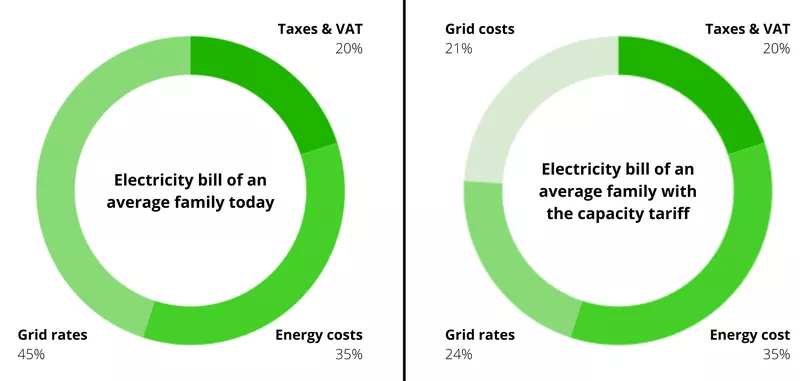What is the capacity tariff?
As experts in building automation and sustainability, we keep a close eye on the energy landscape. And we’ve noticed that recently, despite getting a lot of attention in the media, there remain many questions about the capacity tariff. What is it exactly? How is it calculated? What difference does it actually make to your energy bill? Can smart controls provide a solution?
So now it’s time to tell you everything you need to know about the capacity tariff in nice simple terms.

1. Why was the capacity tariff introduced?
Our power grids are under tremendous pressure. On the one hand, it’s because they now have to engage in two-way rather than one-way communications, while on the other, we are all consuming more and more electricity. Here’s a short explanation of both issues.
1.1 Two-way traffic connection with the power grid
Electricity grids were originally designed for one-way traffic: producers introduced electricity to the grid and households and businesses consumed it. Today, however, this concept has evolved into two-way traffic. We can now produce our own electricity through renewable energy and feed it back to the grid. Just think about solar panels or wind turbines. This places variable pressure on the grid, which is hard-to-predict and control.
1.2. Rising demand for electricity
Moreover, our society is moving ever more quickly towards a CO2-neutral society where we will increasingly heat our homes using electricity (heat pumps) instead of fossil fuels, it will be mandatory for company cars to be electric from 2026 onwards, and more. As a result, the grid is experiencing increasingly high peaks. Spikes are caused, for example, by cooking in the evening when we all get home from work, running the washing machine and dryer, plugging in a electric car, etc.
1.3 Preventing Overload
In order to prevent an overload of the grid, the Flemish Electricity and Gas Market Regulator (VREG) wants to encourage everyone to use the grid more efficiently. To achieve this, a capacity tariff has been introduced. In more specific terms, this means that people will pay more if they cause high spikes of usage. Using multiple appliances at the same time might cause one of these high spikes: think, for example, of charging your electric car while your oven is on and the washing machine is running.
2. How is the capacity tariff calculated?
Before we can explain how your costs will be calculated in the future, it’s important to understand how your energy bill is structured so you can see what changes there will be to that structure. This is because the capacity tariff is not an additional tariff, but rather another way of distributing grid costs to all customers.
2.1. Your energy bill – with and without the capacity tariff
At the moment, your energy bill consists of 3 parts: the energy cost, the grid rate and various taxes and VAT. Energy costs and charges are self-explanatory. The grid rate, on the other hand, could use some additional explaining.

Today, the grid rate covers the costs of various items, including the construction and maintenance of the electricity grid. For a typical family, this makes up about 45% of the total bill. The price of this grid rate is determined on the basis of your effective purchase from the grid (kWh).
As of the middle of 2022 (assuming it is not postponed again, of course), the structure and calculations used for this part of your energy bill will change. Part of the grid tariff will then be calculated based on the grid cost (in kW) that you use and not, therefore, the effective amount that you remove from the grid (kWh). This amounts to about 21% of the total bill for a typical family. The other grid rates will continue to be calculated on the basis of the actual kWh you consume (i.e. your usage).
Introducing the capacity tariff will also mean an end to the day and night tariffs that we’re used to having. Where we might have previously saved costs by turning on our washing machine after 10 p.m., the time at which we consume energy will no longer make a difference.
2.2. How the VREG determines your grid cost
So that it can generate your energy bill, the VREG will look at your highest quarterly peak in kilowatts (kW) each month. The average level of consumption within that quarter is defined as a peak; this is also called the monthly peak. To give you a better idea of this concept, here’s an example. Suppose you heat a bowl of soup in the microwave for 1 minute at 1000 watts, the peak is not 1000 watts, but 1/15th of 1000 watts, i.e. 66 watts.
Of course, you won’t be billed on a monthly basis, but rather on an annual basis. That is why VREG will take an average of the 12 monthly peaks. Based on this average, it will then be possible to determine your effective grid cost.
Note: it’s important to realise that quarterly peaks are not measured using regular quarter hour slots, so between 6pm and 6:15pm, for example. Instead, VREG will look at a quarter of an hour being defined as “a time span of 15 minutes“. So a peak might therefore also run between 6:07 p.m. and 6:22 p.m. or from 5:56 p.m. to 6:11 p.m.
3. The capacity tariff and smart meters
Measurements = knowledge. In 2019, Flanders therefore began to install digital meters. These meters are able to measure, in detail, energy consumption and therefore consumption peaks. By 2024, the intention is for 80% of homes to have such a meter. By the end of 2029, this should be the case in all homes.
You may already feel the effects… and this is a problem! The capacity tariff relies entirely on those peaks, but an analogue meter is not capable of measuring them. How does VREG solve this?
Households with a conventional electricity meter will have to pay a fixed contribution. This corresponds to a consumption peak of 2.5 kW. The amount also corresponds to the minimum contribution that families pay if they use a digital meter; but this is the case, even if your peak consumption is lower.
4. The impact of the capacity tariff on your energy bill
4.1 For residents
High energy prices are a hot topic in the media. Especially so after Flemish Energy Minister Zuhal Demir discovered, thanks to a UGent study, that a third of consumers will have to pay more for their energy bills. But in what situations should you pay more and in what situations should you not?
Voor wie een verbruik heeft tussen de 900 tot 2.350 kWh per jaar blijft de imThe study shows that the impact of the capacity tariff is greatest among households whose annual electricity consumption is below 900 kWh per year. So think of small families who live in an apartment or second homes. Their monthly peak is less than 2.5 kW, but since this is the minimum contribution, they will have to pay it anyway.
For those whose energy consumption falls between 900 and 2,350 kWh per year, the impact is limited to between 25 and 50 euros. If your annual consumption is somewhere between 2,350 and 3,500 kWh, the effect can be both positive and negative. This is where the spread of peak consumption becomes a determining factor.For larger consumers, such as owners of an electric car or heat pump, for example, the picture looks rosier; they could make estimated savings of 100 euros if they spread their consumption. If they charge their electric vehicle at the same time as when their heat pump is in use, or another device that uses a large amount of electricity, then they will experience a serious increase in cost.
4.2 For building managers
The capacity tariff also has an impact at a collective level. Look at the example of an apartment building with only 3 apartments. The meter for the communal areas controls the LED lights in the hallway with a timer. The consumption is round about 50kWh/year. The quarter-peak power is therefore <0.1 kWp.
However, if you look at the information above, it’s obvious that this will be automatically increased to 2.5 kWp by the capacity tariff. The result is that for this building, each person will pay approximately €300 for only 50kWh.
This is obviously a very exceptional situation. Generally speaking, in an apartment building, there is also a lift, which consumes a lot of power.
5. So how can you keep your energy bill affordable?
In general, there is only one way to keep your energy bill affordable: spread your consumption. This, however, is easier said than done.
5.1 Know what you consume
Again, imagine the scenario described in the last paragraph. You’ve got your electric car charging when the heat pump kicks into action without you knowing it. This leads to a consumption peak. The only way to avoid this peak is if you know that both devices are active and consuming electricity. For this, of course, you’re going to need real-time insight into your consumption at a personal and/or communal level. Fortunately, this is possible thanks to Smart Metering.
5.2 Smart controls to the rescue
Of course, you’re not going to be staring at the Renson Smart Living platform every moment of the day…. That’s why we initially created the ability to configure notifications. For example, Renson can make sure that when your heat pump kicks in, you receive a notification. This means you’d be able to remotely stop the energy supply to your charging point(s). Making sure that the devices in your home or building are smart-enabled and can be controlled like this, makes it possible to keep your energy bill – even on the capacity tariff – within limits.
For Energy Service Companies (ESCO), Renson goes a step further. Looking at a neighbourhood or whole building, we can set up an Energy Management System (EMS) to optimise energy flows. Imagine having a building with solar panels, charging stations, a battery and a communal electric water heater. Within this building, the energy demand is generally highest when the solar panels yield the least (morning and evening). To smooth out the peaks and reduce grid costs, you need to optimise the energy flows. The Renson EMS is designed so that during the day, when there is a lot of sun and little demand for energy, the output from the solar panels can be used to heat water or charge the battery. Smart controls will ensure that this never happens at peak times. At the same time, in the evening when demand is high, the EMS makes sure not to power the charging stations, or if it does so, to a lesser extent to smooth out consumption peaks. A system like this benefits both the building manager as well as the residents.
Are you looking for a solution for your next project?
Expectations for using smart controls alongside the capacity tariff are clearly high. As a developer, it is becoming increasingly difficult to find a complete solution. This is why we would like to invite you for a meeting where we can answer all your questions and share our expertise with you.